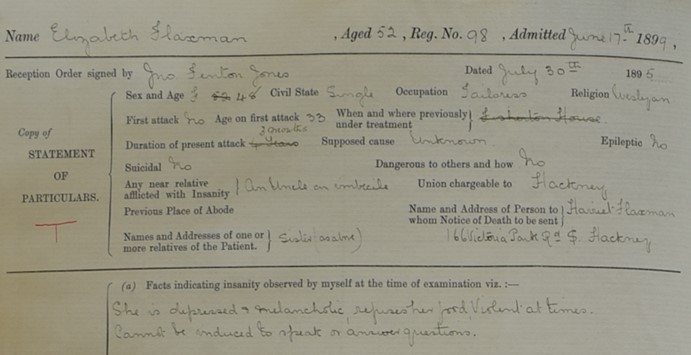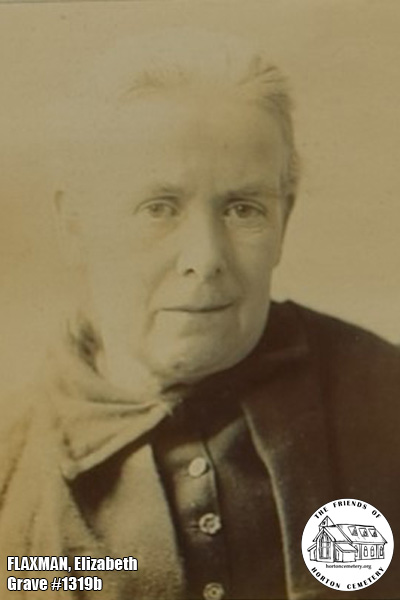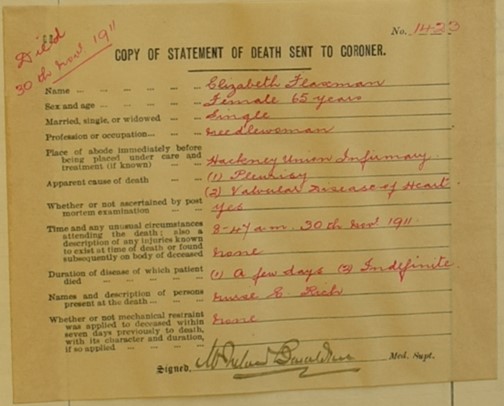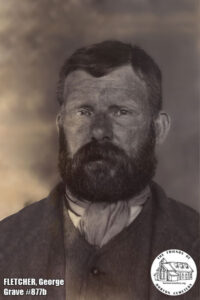b.1846 – d.1911
To research Elizabeth’s story, I first found her birth register on the General Register Office website. This revealed that Elizabeth’s birth was registered in 1846 in the July, August, September quarter in the district of Stepney. Her mother’s maiden name is listed as Whiteman, although this appears to be an incorrect transcription of Wightman.

Elizabeth’s parents, Lucy Wightman and William Flaxman, were married on 16 August 1835 at St James’ in Clerkenwell, Islington. They appear to have had at least ten children together:
- Lucy (b.1836)
- Lucy (b.1838)
- Harriett (b.1840)
- William (b.1842)
- Maria (b.1843)
- Maria (b.1844)
- Elizabeth (b.1846)
- William (b.1848)
- George (b.1850)
- Charles (b.1852)
At least four of their children, Lucy (b.1836-d.1837), William (b.1842-d.1843), Maria (b.1843-d.1843), and Charles (b.1852-d.1854) appear to have died in infancy or childhood.
The 1840s
In the 1841 England Census, the Flaxmans lived on North Street in Mile End Old Town in Stepney. At this point, the household was made up of 25-year-old William, 23-year-old Lucy, and their two daughters, 3-year-old Lucy and 1-year-old Harriett. William’s profession is listed as a carpenter.
The Census shows that Elizabeth’s father, William, was born in Woodbridge, Suffolk. Elizabeth’s mother, Lucy, was born in Great Bealings, Suffolk. Woodbridge has a history of boat building, for example, Sir Francis Drake had his fighting ships built there. Perhaps William learnt his trade as a carpenter in Woodbridge.

Elizabeth was baptised on 9 December 1849 at St Peter’s in Mile End Old Town, Stepney, along with her siblings, Lucy, Harriett, Maria, and William. Her birth date is mistakenly given as 29 August 1845, but we know that she was born in 1846. It is unclear why five of the children were baptised at the same time, especially as Lucy would have been around 11 years old by this time, which was unusually late. Lucy and William’s first child, Lucy, was baptised on 23 December 1836 at St Luke in Finsbury, Islington before she died around a week later. Perhaps she was so weak when she was born that they decided to baptise her very quickly in the likely probability that she would die in infancy.
The 1850s
Elizabeth appears in the 1851 England Census, aged 4, living at 3 Spring Gardens in Mile End Old Town. It shows that Elizabeth was born in Mile End Old Town, most likely at home. Her parents are listed as William (Wilmar) Flaxman and Lucy Flaxman, both born in c.1812. At the time of this census, Elizabeth is living with her parents and five siblings, Lucy (aged 13), Harriett (aged 11), Maria (aged 6), William (aged 2) and George (aged 9 months). As the family do not appear to have any servants, we can speculate that this family did not necessarily have a lot of money.
Elizabeth’s brother, Charles, died in 1854, aged two, and was buried at St Dunstan and All Saints in Stepney in April 1854. He had been baptised in March 1854 at St Peter’s in Mile End Old Town just before he died.
The 1860s
In the 1861 England Census, there is a 14-year-old Elizabeth Flaxman living at 27 Jane Street at St George in the East working as a servant. The only other occupant is 59-year-old Ruth Lissett, who is described as the House Proprietor. We cannot be certain that this is the right Elizabeth as it gives very few details about her but I have been unable to find record of Elizabeth elsewhere.
Elizabeth’s father, William Flaxman, appears as ‘deceased’ on Maria’s marriage certificate in 1867, so we know that he died between 1851 and 1867.
I have been unable to find record of Elizabeth’s parents in the 1860s.
The 1870s
I have been unable to find record of Elizabeth in the 1870s. Her asylum case notes from 1899 state that her first attack was at age 30, so perhaps she was already in some kind of institution.
The 1871 England Census shows that Elizabeth’s 30-year-old sister, Harriett, was living with her 53-year-old mother, Lucy, in Mile End. They also live with two lodgers, 64-year-old Charles Harbon and 75-year-old Mary Kingham. Harriett’s profession is listed as a ‘suit maker’.
In the 1871 England Census, Elizabeth’s 33-year-old sister, Lucy, is living with her husband Joseph Ward and their four children in Mile End Old Town, as well as with a lodger, 68-year-old John McQuillan. John’s profession is given as ‘paper marbler’.
In the 1871 Census, Elizabeth’s 22-year-old sister, Maria, was living with her husband, William Edgerton, and their two young sons in Gillingham, Kent. They also had a servant, Ellen Holland, suggesting they were relatively comfortable.
In the 1871 England Census, Elizabeth’s 20-year-old brother, George, is living with his wife, Mary Ann, in St Pancras, London, with their 3-month-old daughter, Mary Isabel.
The 1880s
In the 1881 England Census, 33-year-old Elizabeth is shown living at 184 Devonshire Street in Mile End Old Town with her 69-year-old mother, Lucy, and 31-year-old brother, William. Her mother was by then a widow. Her brother’s profession is listed as a waiter at an inn, and Elizabeth’s profession is listed as a tailoress. Mile End has been historically associated with tailoring, so it is not surprising that Elizabeth (and her sister Harriett) were tailors. Also living with them was 35-year-old John Allwinkle, a fish porter, and his 29-year-old wife, Sarah, a tailoress. We can speculate that these were lodgers and Sarah was potentially working with Elizabeth as they shared the same profession.
Charles Booth’s poverty map from the late nineteenth and early twentieth century shows that Devonshire Street is classed as ‘fairly comfortable. Good ordinary earnings’ (BOOTH/B/350, p. 29). However, they lived next to a poor area.
Elizabeth’s mother, Lucy, died at age 74 in Mile End Old Town in 1884.
The 1890s
In the 1891 England Census, 44-year-old Elizabeth is shown living with her older sister, Harriett, at 53 Penshurst Road, Hackney. Both of their professions are listed as tailoress. The house was also occupied by 40-year-old James Conners, a gymnastics instructor with his wife Jane and three children. Two of these children are listed as having been born in Ireland.
Elizabeth was admitted to Fisherton House Asylum in Salisbury, Wiltshire on 31 July 1895 and discharged to Manor Asylum on 17 June 1899.

These dates match her case notes. Manor asylum had only been opened that same year to treat people detained under the Lunacy Acts, whereas Fisherton was established as a private licensed asylum.

The case notes state that Elizabeth was single, her occupation was as a tailoress, and her religion was Wesleyan. Her first attack was at age 33 and it states that the duration of the present attack has lasted three months. The supposed cause is unknown. It states that she is not epileptic or suicidal, and is not dangerous to others. It states that her uncle is an ‘imbecile’. It states that the name and address of person to whom Notice of Death is to be sent is Elizabeth’s sister, Harriet (sic) Flaxman, living at 166 Victoria Park Road, Hackney.
The case notes describe Elizabeth’s psychiatric symptoms, stating that ‘she is depressed [and] melancholic, refuses her food, violent at times. Cannot be induced to speak or answer questions.’ Her mental state is described as ‘does not know how old she is, how long as has been here, where she came from, or what month or year this is… States that she is depressed… but is unable to assign a cause.’ Her diagnosis is given as dementia.

There are photos of Elizabeth attached to the case notes:
 |  |  |
| 1899 | 1899 | 1907 |
The 1900s
The 1901 England Census shows 55-year-old Elizabeth (listed only as ‘EF’) living at Manor Asylum as a ‘pauper patient’. All of the patients on record only appear by their initials. The census mistakenly lists Elizabeth’s age as 53 and gives her profession as a tailoress/tailor.
Elizabeth’s case notes tell us that she was ‘Discharged Recovered’ on 23 October 1906. About two weeks earlier, on 10 October, her case notes state that ‘she is now quite well has not been depressed for about 8 months’. These records do not say where she was discharged to.
We know, however, that Elizabeth was discharged to Sidney Road Workhouse, Hackney on 23 October 1906. Her profession is given as ‘sewing’. On 29 October 1906, she was discharged from the workhouse to the infirmary. We can assume that Elizabeth stayed in the infirmary for a couple of months and then got readmitted to the Manor Asylum.
The UK, Lunacy Patients Admission Registers, 1846-1912 states that Elizabeth was readmitted to Manor Asylum on 1 January 1907, less than three months after she was discharged.

Her second set of case notes claim that Elizabeth’s mental disease is ‘recurrent melancholia’. Under facts indicating insanity, it states that ‘It is with the utmost difficulty that she can be induced to speak or to answer questions. She sits in the same position for hours at a time without moving or speaking to any of the other patients. She refuses her food. Is dirty in her habits [and] totally unfit to take care of herself’. Her weight is listed as only 6 stone, which is unsurprising given that she was refusing food.
The case notes state that she was still doing some needlework in 1906, at the age of 60.
Elizabeth looks noticeably older and thinner in the photos from her 1907 case notes than in the photos from her 1899 case notes.
The 1910s
The 1911 England Census shows 65-year-old Elizabeth (again listed only as ‘EF’) living at Manor Asylum. Her personal occupation is listed as ‘needlewoman’.

The informant of Elizabeth’s death was her brother, George Flaxman, who was living in Highgate at the time. This indicates that the two siblings were relatively close as many deaths were registered by the asylum superintendent.
The UK, Lunacy Patients Admission Registers, 1846-1912 states that Elizabeth died on 30 November 1911, aged 65. Her second set of case notes state that she died of pleurisy and ‘valvular disease of heart’.

John Flaxman
Elizabeth’s case notes from 1899 for her admission to Manor Asylum state that she has an uncle who is an ‘imbecile’. I believe that this uncle is John Flaxman, Elizabeth’s father’s brother. In the 1861 England Census, 38-year-old John was an ‘inmate’ of Woodbridge Union Workhouse in Nacton and is listed as blind.
I found what appears to be a record of John in the same workhouse in the 1871 England Census and it states that he is an ‘idiot’. It was difficult to find this record because his name was incorrectly transcribed as ‘John Flatman’ and his age is given as 18, rather than 48. It does, however, state that he was born in Woodbridge, Suffolk, which is where his brother William Flaxman was also born.
According to his death certificate, John died on 6 May 1875 at Union Workhouse Nacton, in Suffolk. The cause of death is listed as ‘Constitutional Debility several years, Diarrhoea 10 days. The informant of John’s death was the master of the workhouse, rather than a family member. We don’t know whether he still had contact with family members when he was in the workhouse.
AUTHOR’S NOTES
Unfortunately, I couldn’t find a record of Elizabeth’s father’s death, as his will and probate would have given an indication of the family’s wealth. We know he died at some point between 1851 and 1867 (as he appears as ‘deceased’ on Maria Flaxman’s marriage certificate in 1867) but do not know the exact date.
It is incredible how quickly Elizabeth was readmitted to Manor Asylum after she was ‘Discharged Recovered’ in October 1906. She was only at Sidney Road Workhouse in Hackney for six days before she was discharged to the infirmary and subsequently readmitted to Manor Asylum, where she remained until her death four years later in 1911.
Researching Elizabeth’s life has again demonstrated how differently people with mental illnesses were treated in the nineteenth and early twentieth centuries. In the 1901 England Census, Elizabeth is only listed by her initials (‘EF’) and her uncle, John Flaxman, was listed as an ‘idiot’ in the 1871 Census. Perhaps we cannot judge by today’s standards, but it is striking how little respect these people seem to have been given.



